
Bohemian Rhapsody, Queen’s iconic masterpiece, is now available as piano sheet music, offering pianists a chance to master its intricate composition and emotional depth․ This PDF arrangement captures the song’s complexity, blending ballad, opera, and rock elements, making it a must-play for music enthusiasts worldwide․
Overview of the Song and Its Popularity
First released in 1975 by Queen, Bohemian Rhapsody is a groundbreaking rock ballad that defies traditional song structures․ Its unique blend of operatic vocals, hard rock, and classical elements captivated global audiences, making it one of the band’s most iconic tracks․ The song’s popularity soared due to its innovative production and emotional depth, topped the UK Singles Chart for nine weeks, and remains a timeless classic․ Its enduring appeal has led to widespread demand for piano sheet music, allowing pianists to bring this masterpiece to life․
Why “Bohemian Rhapsody” is a Favorite Among Pianists
Bohemian Rhapsody captivates pianists with its rich, complex arrangement and dramatic shifts in style․ The song’s unique structure, blending balladic melodies, operatic crescendos, and powerful rock sections, challenges and inspires pianists to explore their technical and expressive range․ Its layered harmonies and dynamic transitions make it a rewarding piece to master, while its universal appeal ensures it resonates with diverse audiences․ As a result, pianists worldwide seek piano sheet music to interpret this iconic piece and connect with its enduring musical brilliance․
Availability of Sheet Music in PDF Format
The Bohemian Rhapsody piano sheet music is widely available in PDF format, catering to pianists of all skill levels․ Websites like pianoshelf․com and other platforms offer free downloads, while premium sites provide high-quality, professionally arranged versions․ The sheet music is often presented in its original key, Bb Major, and includes lyrics, making it a comprehensive resource for musicians․ With over 10 pages of detailed notation, pianists can easily access and print this iconic piece, ensuring they can practice and perform with precision and flair․ Its widespread availability makes it a staple for pianists worldwide․

Where to Find “Bohemian Rhapsody” Piano Sheet Music PDF
Pianists can find Bohemian Rhapsody piano sheet music PDF on websites like pianoshelf․com and other music platforms, offering both free and paid, high-quality versions for all skill levels․
Free Download Options
Free Bohemian Rhapsody piano sheet music PDF downloads are available on platforms like pianoshelf․com and other music-sharing websites․ These sites offer high-quality arrangements, perfect for pianists of all skill levels․ Many versions are transcribed for solo piano, capturing the song’s iconic ballad, opera, and rock sections․ While some sheets are simplified for beginners, others remain faithful to the original composition․ Users can download these PDF files directly, making it easy to practice and perform this beloved classic․ Donations are often appreciated to support the creators and maintain these resources․
Paid Sheet Music Platforms
Premium platforms like Musicnotes and Sheet Music Plus offer high-quality Bohemian Rhapsody piano sheet music PDF downloads․ These paid versions provide meticulously transcribed arrangements, ensuring accuracy and fidelity to the original composition․ Many feature interactive tools, enabling users to adjust tempos or transpose keys․ Officially licensed sheets are available, guaranteeing authenticity for serious pianists․ While these require a purchase, they deliver professional-grade materials, making them ideal for those seeking precise and polished renditions of this iconic piece․ These platforms are trusted sources for musicians seeking reliable sheet music․
Community-Driven Sheet Music Websites
Community-driven platforms like Pianoshelf and MuseScore offer a vast library of user-contributed Bohemian Rhapsody sheet music․ These websites foster collaboration, allowing musicians to share and discover unique arrangements․ Many contributors provide detailed transcriptions, ensuring the sheet music captures the song’s intricate layers․ While some arrangements are free, others may require a small fee․ These platforms are invaluable for pianists seeking diverse interpretations or simplified versions of the piece, making them a great resource for both beginners and advanced players alike․ The collective effort ensures a rich and varied selection for enthusiasts․
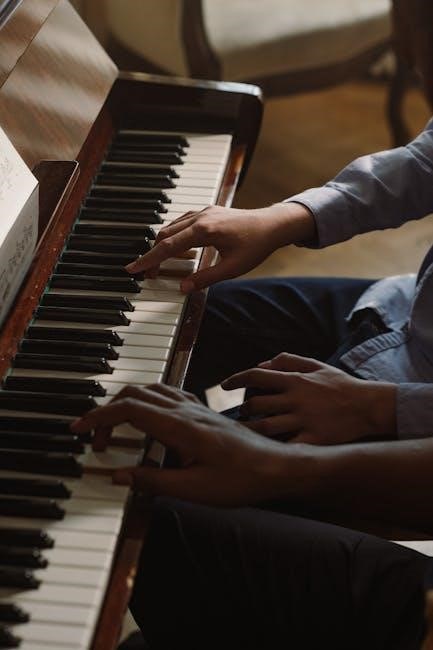
Structure and Composition of the Song
The song’s six-part composition blends ballad, opera, and hard rock, making it uniquely complex․ Its intricate structure and dramatic transitions present a thrilling challenge for pianists to master․
Understanding the Song’s Complex Structure
Bohemian Rhapsody is renowned for its unconventional six-part structure, blending ballad, opera, and hard rock․ The piano sheet music mirrors this complexity, guiding pianists through dramatic transitions and emotional depth․ From the intimate ballad opening to the operatic crescendo and hard rock finale, the song’s arrangement demands precision and expression․ Its intricate composition, with multiple key changes and tempo shifts, challenges even seasoned pianists, making it a rewarding piece to master․ The sheet music captures the essence of Freddie Mercury’s vision, offering a detailed roadmap for interpretation and performance․
Breaking Down the Song into Sections
The Bohemian Rhapsody sheet music is divided into distinct sections: the ballad, opera, and hard rock․ The piano arrangement begins in Bb Major, transitioning through dramatic key changes and tempo shifts․ The ballad section features delicate arpeggios and emotional melodies, while the opera part demands intricate fingerwork and dynamic range․ The hard rock finale showcases powerful chords and rhythmic intensity․ With 10 pages of detailed notation, the sheet music guides pianists through these sections, ensuring clarity and precision․ This breakdown highlights the song’s complexity, making it easier to practice and perform effectively․
Key Signatures and Chord Progressions
The Bohemian Rhapsody sheet music features a complex array of key signatures and chord progressions, starting in Bb Major․ The ballad section uses minor keys like A minor and F minor for emotional depth, while the opera part transitions through dramatic key changes․ The hard rock finale relies on powerful, driving chords in E minor and B minor․ These shifts create a dynamic journey, blending delicate arpeggios with intense rhythmic patterns․ The sheet music meticulously guides pianists through these changes, ensuring a seamless performance of the song’s iconic structure and mood․

Difficulty Level and Skill Requirements
Bohemian Rhapsody is technically demanding, requiring advanced piano skills․ It involves complex arpeggios, rapid chord transitions, and nuanced dynamics, making it suitable for intermediate to advanced pianists seeking a challenging piece․
Evaluating the Technical Difficulty
Bohemian Rhapsody is renowned for its technical complexity, featuring intricate arpeggios, rapid chord progressions, and dramatic tempo changes․ The song’s structure, blending ballad, opera, and rock elements, demands advanced piano skills, including precise finger dexterity, hand independence, and dynamic control․ Pianists must master challenging sections like the operatic arpeggio runs and the hard rock finale’s powerful chord sequences․ The piece’s emotional depth and structural complexity make it a formidable yet rewarding challenge for experienced musicians․
Recommended Skill Level for Pianists
Bohemian Rhapsody is best suited for advanced pianists due to its intricate composition and demanding techniques․ The piece requires strong finger dexterity, hand independence, and dynamic control․ While intermediate pianists can attempt simplified arrangements, the full version demands advanced skills, including mastery of arpeggios, rapid chord progressions, and nuanced tempo changes․ Professionals and experienced musicians will find it a rewarding challenge, while beginners may need to build up to its complexity․ The song’s diverse sections ensure a fulfilling experience for those with the requisite skills․
Simplified Arrangements for Beginners
Beginners can enjoy Bohemian Rhapsody through simplified arrangements that break down the song’s complexity․ These versions focus on the melody and basic chords, omitting intricate sections․ They allow learners to grasp the song’s essence without overwhelming technical demands․ Available in various skill levels, these arrangements help build confidence and skills progressively․ As pianists advance, they can incorporate more complex elements, making Bohemian Rhapsody an accessible and rewarding piece for players of all levels․ Simplified sheets are widely available online, offering a stepping stone to mastery․

Tips for Playing “Bohemian Rhapsody” on Piano
Mastering Bohemian Rhapsody requires patience and practice․ Start with slower tempos, focus on dynamics, and maintain rhythm consistency; Break the piece into manageable sections for easier learning․
Mastering the Ballad Section
The ballad section of Bohemian Rhapsody is a showcase of emotional depth and technical nuance․ Focus on maintaining a steady tempo and expressive dynamics to convey the song’s dramatic intensity․ Practice arpeggios and chord progressions to achieve smooth transitions․ Pay attention to phrasing and legato playing to capture Freddie Mercury’s vocal-like delivery․ Start with slower tempos and gradually increase speed as you build confidence․ Emphasize the melodic flow and harmonic richness to create a captivating performance․ This section sets the foundation for the song’s dramatic progression, making it essential to perfect․
Approaching the Opera Section
The opera section of Bohemian Rhapsody is a technically demanding and dramatically intense part of the song․ To master it, focus on precise finger dexterity and dynamic control․ Practice arpeggios and scales to navigate the rapid key changes and complex harmonies․ Emphasize dramatic contrasts, transitioning seamlessly from soft, delicate passages to powerful, resonant chords․ Use a metronome to maintain rhythm during the faster sections․ Pay attention to phrasing and articulation to capture the operatic feel․ Start slowly, gradually increasing tempo as confidence grows․ This section requires patience and dedication to deliver its full emotional impact․
Perfecting the Hard Rock Finale
The hard rock finale of Bohemian Rhapsody demands powerful, driving rhythms and bold chord progressions․ Focus on maintaining a strong, steady beat and emphasizing dynamic contrasts; Practice the iconic guitar riffs adapted for piano with a firm, percussive touch․ Build finger strength and stamina for the intense arpeggios and octaves․ Pay attention to timing and synchronization, especially during the climactic build-up․ Use a metronome to ensure accuracy at faster tempos․ This section requires energy, precision, and a commanding stage presence to deliver its electrifying conclusion effectively․
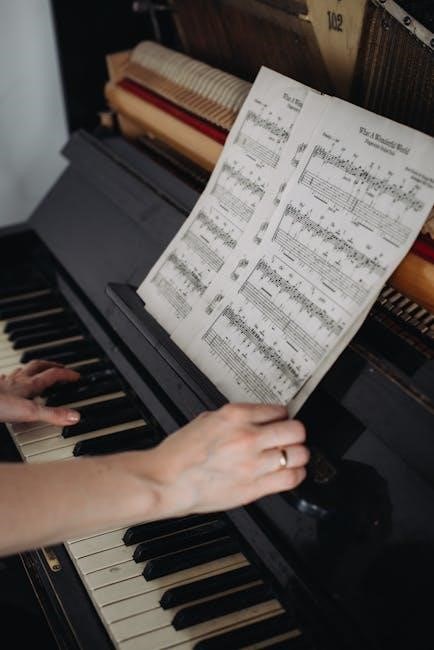
Historical Significance of the Song
Bohemian Rhapsody, released in 1975, revolutionized music with its genre-blending structure․ Freddie Mercury’s innovative composition and the song’s cultural impact have solidified its status as a rock masterpiece․
Freddie Mercury’s Creative Process
Freddie Mercury’s creative process for Bohemian Rhapsody was highly innovative and meticulous․ He composed much of the song on his grand piano, blending operatic and rock elements․ Mercury’s vision was to create a piece that defied conventional structures, resulting in a six-minute epic that combined ballad, opera, and hard rock sections․ His ability to merge diverse musical styles showcased his genius․ The song’s complexity and emotional depth reflect Mercury’s dedication to pushing artistic boundaries, leaving a lasting legacy in music history․ His piano, now a historic artifact, remains a testament to his creative brilliance․
The Piano Used by Freddie Mercury
The baby grand piano Freddie Mercury used to compose Bohemian Rhapsody and other iconic songs was sold at auction for over $1․7 million․ Purchased in 1975 and imported from Japan, this historic instrument played a pivotal role in shaping Queen’s discography․ Mercury’s creative process often began with this piano, where he crafted intricate melodies and harmonies․ Its sale highlights the enduring legacy of Mercury’s artistry and the significance of the tools that helped shape his musical genius․ This piano remains a cherished piece of music history, symbolizing Mercury’s lasting impact on rock music․
Cultural Impact and Legacy
Bohemian Rhapsody has left an indelible mark on music history, transcending genres and inspiring countless covers, parodies, and tributes․ Its innovative blend of rock, opera, and ballad styles revolutionized music production and video art․ The song’s iconic music video, one of the first to gain heavy rotation on MTV, set a new standard for visual storytelling in music․ Its influence extends to live performances, with Queen’s electrifying renditions becoming legendary․ Today, it remains a cultural phenomenon, featured in films, TV shows, and even sports events, ensuring its enduring relevance and appeal across generations․
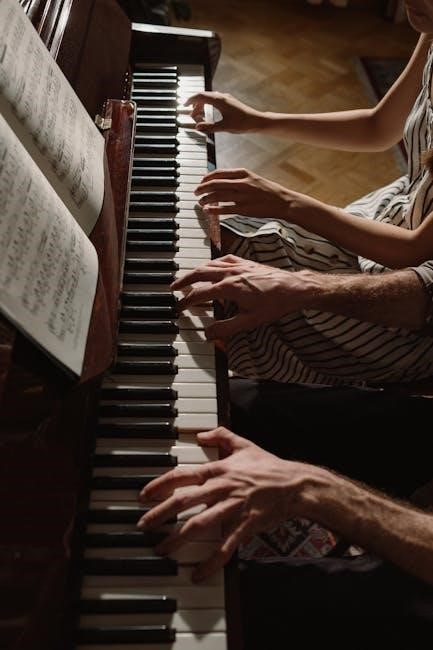
Practice and Performance Advice
Mastering Bohemian Rhapsody requires patience and dedication․ Start with slower tempos, focusing on intricate sections like the opera part․ Gradually increase speed while maintaining emotional expression and technical precision to deliver a captivating performance․
Breaking the Song into Practice Sections
Start by isolating the ballad section, focusing on emotional expression and chord accuracy․ Practice arpeggios and melodic lines to ensure clarity․ Next, tackle the operatic part, practicing complex runs and harmonies․ Emphasize dynamic control and vocal-like phrasing․ The hard rock finale demands precise timing and powerful chord progressions․ Finally, the outro requires a grand, dramatic touch with sustained notes․ Practice each section slowly, loop challenging phrases, and gradually increase tempo․ This method ensures mastery and a cohesive performance, capturing the song’s essence effectively․
Using Metronomes and Tempo Guides
A metronome is essential for maintaining consistent timing in Bohemian Rhapsody․ Start by setting it to the ballad section’s tempo (around 70 BPM) to ensure steady arpeggios and chord progressions․ Gradually increase the tempo as you transition to the rock sections, aiming for 120 BPM․ Tempo guides can help navigate the song’s dynamic shifts, particularly during the operatic and hard rock segments․ Practice each section with a metronome to build accuracy and fluidity, ensuring seamless transitions between contrasting tempos and time signatures․ This tool is crucial for mastering the song’s technical and rhythmic challenges effectively․
Performance Tips for Stage Presence

When performing Bohemian Rhapsody on piano, captivate your audience with dynamic stage presence․ Embrace the song’s theatrical nature by expressing its emotional depth through facial expressions and body language․ During the ballad section, maintain a connection with the audience using subtle movements․ In the operatic part, channel Freddie Mercury’s charisma with dramatic gestures․ For the hard rock finale, convey energy and passion through powerful playing and engagement․ Practice transitions smoothly to maintain flow and confidence․ Own the stage, and let the music guide your performance, ensuring a memorable experience for everyone․
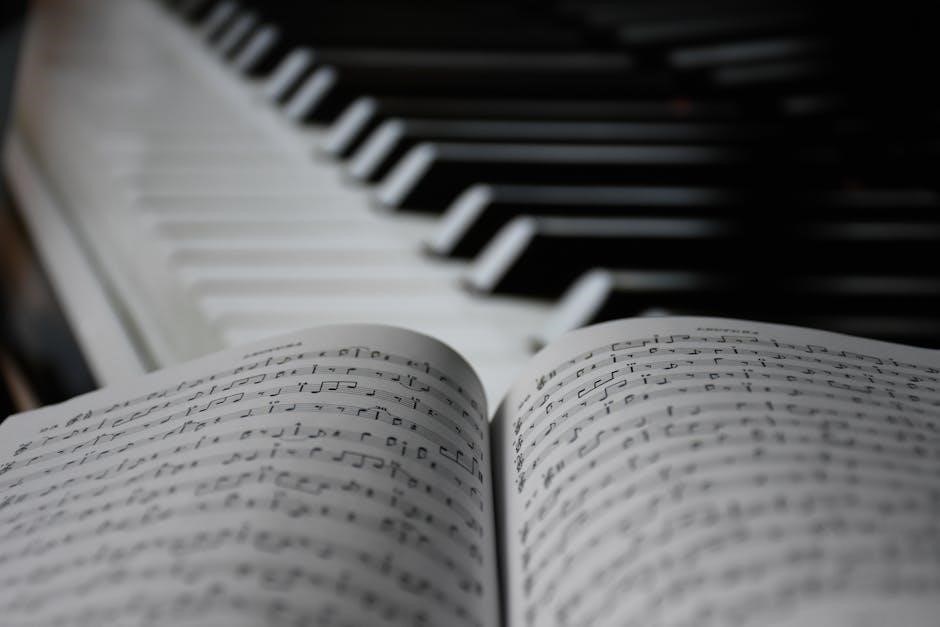
Interesting Facts About the Song
Bohemian Rhapsody was composed on a piano Freddie Mercury used, which later sold for $1․7 million at auction․ The song’s innovative recording techniques and iconic music video revolutionized the industry, making it a cultural phenomenon․
Recording Techniques and Innovations
The recording of Bohemian Rhapsody was groundbreaking, utilizing multitrack recording to layer vocals and instruments․ Freddie Mercury’s innovative use of studio technology created the song’s operatic sections, blending classical and rock elements seamlessly․ The grand piano played a central role in the composition, with intricate arrangements that showcased Mercury’s compositional genius․ These techniques not only set a new standard for music production but also highlighted the song’s theatrical and emotional depth, making it a timeless classic in rock music history․
Lyrics and Their Meaning
The lyrics of Bohemian Rhapsody are a poetic exploration of life, death, and redemption, written by Freddie Mercury․ The song’s operatic sections and dramatic transitions reflect a narrative of personal turmoil and philosophical questioning․ The iconic line, “Galileo, Galileo, Galileo, Figaro,” showcases the song’s theatrical flair and Mercury’s creative genius․ The lyrics, though abstract, resonate with universal themes of struggle and transformation․ Interestingly, the original lyric sheets for the song were auctioned, highlighting its historical and cultural significance as one of rock music’s most enduring masterpieces․
The Song’s Music Video and Its Influence
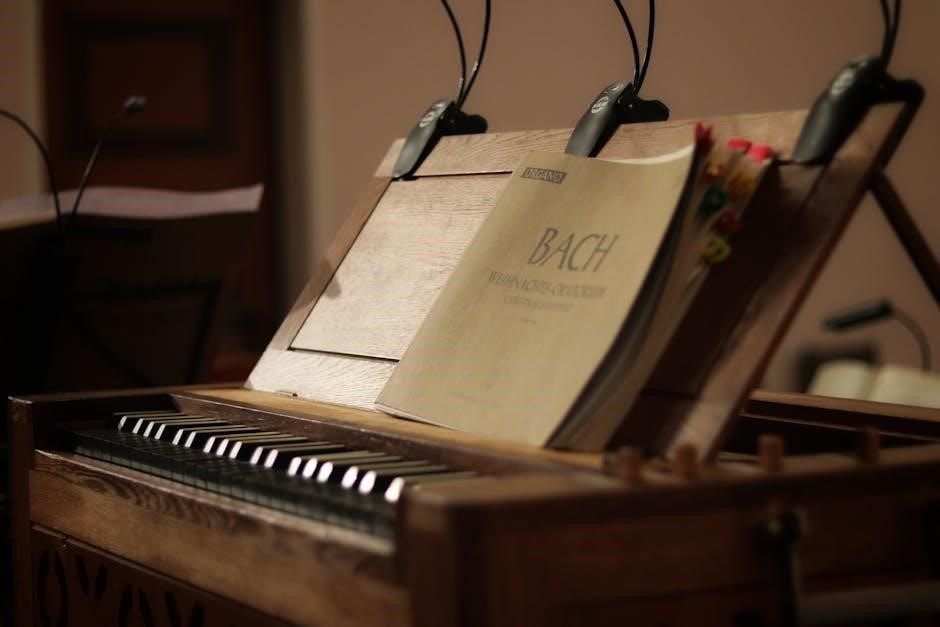
Bohemian Rhapsody’s groundbreaking music video, released in 1975, revolutionized the medium․ Directed by Bruce Gowers, it featured dramatic visuals, intricate lighting, and iconic scenes that matched the song’s operatic and rock elements․ The video’s innovative use of special effects and close-ups set a new standard for music videos, influencing countless artists and videos thereafter․ It became one of the first videos to heavily rotate on MTV, further cementing its legacy․ The video’s theatricality and Freddie Mercury’s charismatic presence have made it an enduring symbol of Queen’s creativity and impact on popular culture․
Bohemian Rhapsody remains a timeless masterpiece, with its piano sheet music offering pianists a chance to embrace its complexity and artistry․ The song’s enduring appeal ensures it continues to inspire musicians worldwide․
Final Thoughts on Playing “Bohemian Rhapsody”
Playing Bohemian Rhapsody on piano is a rewarding experience, blending technical challenge with emotional depth․ The song’s intricate structure demands dedication and practice, but the payoff is immense․ Pianists can master its iconic sections, from the ballad’s tenderness to the opera’s dramatic flair and the rock finale’s intensity․ It’s essential to balance technique with feeling, capturing Freddie Mercury’s original vision․ With persistence and passion, pianists of all levels can bring this legendary piece to life, connecting with audiences through its timeless music․
Encouragement for Aspiring Pianists
Embarking on Bohemian Rhapsody is a thrilling journey for pianists, offering a chance to grow musically and connect with one of rock’s greatest anthems․ While challenging, the song’s emotional depth and iconic sections make the effort deeply rewarding․ Aspiring pianists should embrace the process, breaking the piece into manageable parts and practicing with patience․ The availability of high-quality PDF sheet music and community support makes it accessible to all skill levels․ With dedication, pianists can master this masterpiece and share its timeless beauty with audiences, inspiring others through music․